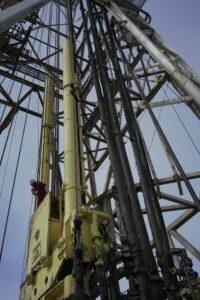
Transit & The Vestnesa Ridge

On the morning of June 7th, the JOIDES Resolution threw off its mooring lines and set sail towards the North Sea. With the port of Amsterdam roughly 30km inland, Expedition 403 would begin with panoramic views of the Dutch countryside as it made its way towards the sea. Giant modern windmills towered over the ship as two tugboats led the way to Lock IJmuiden, which is used to control water height in the canals that lead into the densely populated city center. With Amsterdam sitting so far below sea level, the attention given to climate and rising oceans is out of necessity. The lock acting as a gate into the North Sea served as an oddly appropriate beginning for Expedition 403—the drilling destination can be considered a sort of “gate” into the Arctic, and a better understanding of it could have a direct effect on the predictions of rising sea levels.
The Fram Strait is a deep-water passage that connects the Arctic Ocean and the Northern Atlantic. Sitting between Greenland and Svalbard, the exchange of heat, moisture, and salt between the two oceans is a strong forcing mechanism for climate change both regionally and globally. A significant focus for many of the researchers onboard is the modality of decay of a former ice sheet that covered Svalbard and the Barents Sea roughly 21.000 years ago and shared many characteristics with the presently most vulnerable ice sheet on the planet, the Western Antarctic Ice Sheet (WAIS).

The lock slowly filled with water and opened its gates, leaving the tugboats behind and revealing open waters ahead. Still far from the first sampling site, the transit up along the coast of Norway would take seven days, with waves reaching as high as four meters. After onboarding and safety trainings the scientists would take the long transit to break into working groups and prepare for the arrival of samples. As the ship made the voyage further north the sun would hang higher and longer throughout the day. On the third day of transit, the faint glow of dusk would be the closest thing to night the crew would experience over the next two months. During the summer months, at higher latitudes, the sun will just run laps around the boat, never dipping below the horizon line.

The mix of sea ice movement and small window of seismic opportunity (seismic tests are only permitted in June due to vulnerable whale migration patterns in the region) would lead the expedition to settle on the eastern slope of the Vestnesa Ridge as the first sampling site. Exactly one week from departure, the crew would arrive on site. Greeted with a sea as calm as glass, drilling preparation would begin almost immediately. After the long transit the excitement of the science party was palpable in the labs as everyone huddled around the door to the catwalk waiting for the first core on deck. Friday evening at roughly 9:00pm, the first core would begin making its way up the drill pipe. In the last moments Lucinda Duxbury, a microbiologist from the University of Tasmania, had the brilliant idea to play “Ecstasy of the Gold” by Ennio Morricone over the lab’s sound system. In an appropriate pairing, the spaghetti western’s orchestral music played as the first core arrived onto to the catwalk, successful sample retrieved.
After the first core arrived on deck, the stream of samples was continuous. Deemed a high recovery expedition, the total amount of core recovered during Expedition 403 is anticipated to be over 5,000 meters. The flow of samples remained uninterrupted until challenges arrived midweek.

The indications of gas hydrates downhole posed a potential safety risk, and although not an unexpected complication for the region, evidence was showing a higher potential presence than anticipated. With the help of the trade knowledge of the drill crew and technical support staff, who constantly monitored gas safety measurements, operations proceeded with caution, ultimately leading to over one kilometer of core successfully retrieved.
Under the guidance of the onboard ice navigators Victor Gronmyr and Paul Ruzycki, the decision was made to head northwest to our next drill site. Thrusters will be raised shortly, and to the western slope of the Vestnesa ridge the team will go.